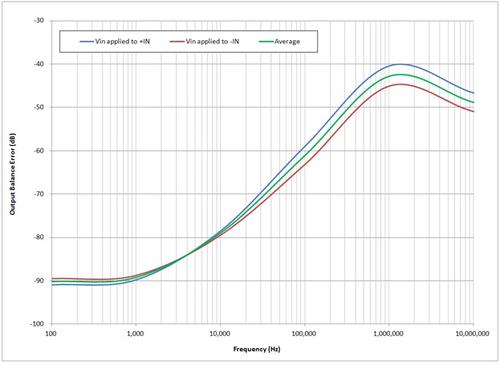Measure Frequency Response on Fully Differential Amplifiers Using Complex Algebra
November 12, 2013

Evaluating the error frequency responses of a fully differential amplifier can be difficult and time consuming if standard measurement techniques are used. This is because the task requires measuring small differential and common-mode error signals. For example, evaluating the amplifier's power supply rejection (PSR) and common-mode rejection (CMR) over frequency requires measuring differential error voltages, while evaluating the amplifier's output balance over frequency requires measuring common-mode error voltages. At low frequencies, these error voltages can be in the order of microvolts.
Traditional methods of measuring the different frequency responses of a fully differential amplifier require either expensive lab equipment (like a differential network analyzer) or specialty interface circuitry to cope with the amplifier's differential output. The complex algebra method uses superposition to reconstruct the amplifier's differential and common-mode output voltages from single-ended output voltage measurements. Since the measurements are single-ended, a single-ended network analyzer can be used without an interface circuit. To perform these measurements, a vector analyzer is preferred since it can output the measured waveforms in complex number form, a data representation that can be easily manipulated during the reconstruction process.
Measurement steps:
Connect the analyzer's output port to the amplifier's input port(s) to provide a stimulus.
Calibrate the measurement path to compensate for losses in the cables and traces.
Connect the analyzer's input port to the amplifier's positive output port.
Measure the frequency response at the amplifier's positive output, making sure to set the analyzer to output a complex number data stream.
VOUTp = Rep + jxImp
Connect the analyzer's input port to the amplifier's negative output port. Do not change the analyzer's settings.
Measure the frequency response at the amplifier's negative output.
VOUTn = Ren + jxImn
Compute the differential and common-mode frequency response using:
VOUT,DIFF = (Rep-Ren) + jx(Imp-Imn) = ReDIFF + jxImDIFF
VOUT,CM = (Rep/2+Ren/2) + jx(Imp/2+Imn/2) = ReCM + jxImCM
Compute the magnitude and phase of the differential and common-mode frequency response:
Mag(VOUT,DIFF) = 20log(√(ReDIFF2+ImDIFF2))
Mag(VOUT,CM) = 20log(√(ReCM2+ImCM2))
Pha(VOUT,DIFF) = atan(ImDIFF / ReDIFF)
Pha(VOUT,CM) = atan(ImCM / ReCM)
Measurement Example 1
In our example, we'll measure the PSR+ of an amplifier, the AD8476, using a Rohde & Schwartz network analyzer. Characterizing an amplifier's PSR+ over frequency is challenging because the input excitation must be injected to the amplifier's power bus. If the amplifier is fully differential, the challenge becomes even greater because you must measure the output voltage's differential-mode component while rejecting the common-mode component. Luckily, the measurement can be simplified using the complex algebra method.
About the Author(s)
You May Also Like


.jpg?width=300&auto=webp&quality=80&disable=upscale)


